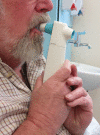A randomised controlled trial to investigate the use of high-frequency airway oscillations as training to improve dyspnoea in COPD
- PMID: 31367635
- PMCID: PMC6661317
- DOI: 10.1183/23120541.00064-2019
A randomised controlled trial to investigate the use of high-frequency airway oscillations as training to improve dyspnoea in COPD
Erratum in
-
Erratum: "A randomised controlled trial to investigate the use of high-frequency airway oscillations as training to improve dyspnoea in COPD". Enya Daynes, Neil Greening, Salman Siddiqui and Sally Singh. ERJ Open Res 2019; 5: 00064-2019.ERJ Open Res. 2019 Aug 30;5(3):00064-2019-AUT. doi: 10.1183/23120541.50064-2019. eCollection 2019 Jul. ERJ Open Res. 2019. PMID: 31516910 Free PMC article.
Abstract
Introduction: Chronic obstructive pulmonary disease (COPD) is characterised by expiratory flow limitation resulting in symptomatic dyspnoea, sputum retention and ventilation heterogeneity. Changes in breathing mechanics affect the ability of respiratory muscles to respond to the ventilatory demands, increasing the sensation of dyspnoea. A high-frequency airway oscillating device has been developed to combine respiratory muscle training and oscillations to improve dyspnoea and sputum retention within COPD.
Methods and analysis: Patients with symptomatic COPD (Medical Research Council Breathlessness scale grade ≥2) will be recruited to a double-blind, randomised, sham-controlled trial. Both groups will follow an 8-week intervention phase using the device three times per day for 5 min at a time. This will be recorded in a self-reported diary. The device applies a flow resistive load and oscillations for combined training. Those receiving the sham device will follow the same protocol; however, the mechanism of action will be removed from the device. Improvements in the Chronic Respiratory Questionnaire-Dyspnoea domain will be the primary outcome measure. Secondary outcomes will explore respiratory muscle function, health-related quality of life, exercise capacity and physical activity. The Lung Clearance Index will be an exploratory outcome. Outcomes will be explored using the most appropriate statistical test, dependent on the sample distribution. Focus groups will be an exploratory outcome and analysed by thematic analysis.
Ethics and dissemination: Ethical approval has been obtained from the East Midlands-Leicester South Research Ethics Committee and the trial has been registered through the ISRCTN Registry. The study results will be disseminated to the appropriate stakeholders through presentations, conferences and peer-reviewed journals.
Conflict of interest statement
Conflict of interest: E. Daynes reports grants from Actegy Ltd during the conduct of the study. Conflict of interest: N. Greening has nothing to disclose. Conflict of interest: S. Sidiqqui has nothing to disclose. Conflict of interest: S. Singh reports grants from Actegy Ltd during the conduct of the study.
Figures




References
-
- Laghi F, Tobin MJ. Disorders of the respiratory muscles. Am J Respir Crit Care Med 2003; 168: 10–48. - PubMed
-
- Gosselink R, De Vos J, van den Heuvel SP, et al. . Impact of inspiratory muscle training in patients with COPD: what is the evidence? Eur Respir J 2011; 37: 416–425. - PubMed
-
- Beaumont M, Forget P, Couturaud F, et al. . Effects of inspiratory muscle training in COPD patients: a systematic review and meta-analysis. Clin Respir J 2018; 12: 2178–2188. - PubMed
-
- Ottenheijm CA, Heunks LM, Dekhuijzen PN. Diaphragm muscle fiber dysfunction in chronic obstructive pulmonary disease: toward a pathophysiological concept. Am J Respir Crit Care Med 2007; 175: 1233–1240. - PubMed
-
- Evans J, Whitelaw W. The assessment of maximal respiratory mouth pressures in adults. Respir Care 2009; 54: 1348–1359. - PubMed
Grants and funding
LinkOut - more resources
Full Text Sources
